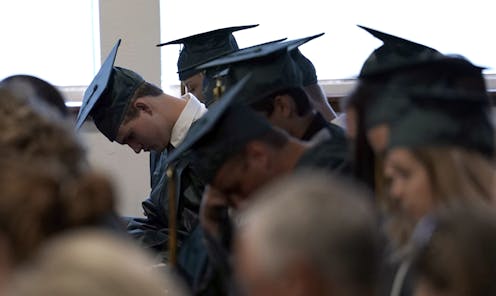It's time to ask deeper questions about school shootings
- Written by Bryan Warnick, Professor of Education, The Ohio State University

To what extent does school – through things like athletics, homecoming royalties or dances – encourage what some political scientists have called the “status tournament of adolescence[1]” that lurks behind many school shootings?
The question – which my colleagues and I raised earlier this year[2] after the Parkland shooting – takes on added importance in light of the most recent American school massacre in Texas[3].
As one reads about school shootings such as the latest incident in Santa Fe, Texas, one often senses a feeling of social anxiety on the part of perpetrator. Americans hold high expectations for schools as places of friendship and romance, yet too often students find alienation, humiliation and isolation. The frustration at these thwarted expectations at least sometimes seems to turn toward the school community itself.
As a researcher who has written[4] about school shootings, I believe this latest school shooting underscores that what is missing from the discussion of school violence prevention is the idea of an educational response.
Current policy responses do not address the fundamental question of why so many mass shootings take place in schools. To answer this question, we need to get to the heart of how students experience school and the meaning that schools have in American life.
An educational response is important because the “target hardening” approach might actually make things worse by changing students’ experience of schools in ways that suggest violence rather than prevent it.
How security measures can backfire
Filling schools with metal detectors, surveillance cameras, police officers and gun-wielding teachers tells students that schools are scary, dangerous and violent places[5] – places where violence is expected to occur.
The “target hardening” approach also has the potential to change how teachers, students and administrators see one another. How teachers understand the children and youth they teach has important educational consequences. Are students budding citizens or future workers? Are they plants to nourish or clay to mold?
Force and control issues
To what extent does the force and coercion employed by many schools contribute to a “might makes right” mentality and associated violence?
It is true that bullying is part of some of the stories of school shooters. Students who are bullied or who are bullies themselves will quite naturally think of schools as places appropriate for violence.
That appears to have potentially been the case in Santa Fe. Some news reports indicate the confessed shooter had been bullied[6] by other students and staff, although school officials dispute that account.
The confessed shooter’s inability or unwillingness to accept rejection also appears to have played a role. According to news reports, the confessed shooter in Santa Fe, 17-year-old junior Dimitrios Pagourtzis, shot and killed eight students and two teachers at Santa Fe High School. His victims included Shana Fisher, who “had four months of problems from this boy,” her mother Sadie Rodriguez told the Los Angeles Times[7] in reference to the shooter.
“He kept making advances on her and she repeatedly told him no,” Rodriguez said.
As Pagourtzis stepped up his efforts to pursue Shana, she eventually stood up to him and embarrassed him in class, the Los Angeles Times reported.
Among school shooters, there is also sometimes a rage against the day-to-day imposition of school discipline and punishment. Since schools are experienced as places of force and control, for some students, they also come to be seen as appropriate places for violence.
Identity and expression
In research on American high schools, one finds the idea that American schools are intertwined with notions of “expressive individualism” – the idea that human beings should find out and be true to who they really are on the inside. Might this also contribute to school shootings?
Suburban high schools, in particular, are seen by the middle class as places to accomplish expressive projects. Sociologist Robert Bulman points out[8], for example, how Hollywood films set in suburban settings focus on student journeys of self-discovery, while urban school films focus on heroic teachers and academic achievement. In the same vein, many suburban school shooters see what they are doing as acts of self-expression.
Reading stories of school shootings, one often finds moments in which the shooters claim that something inside, whether hatred or frustration, needed to find expression. Indeed, even in the latest incident, the confessed shooter reportedly told police that he spared students he liked so that “he could have his story told[9].”
What to do
Of course, it will be difficult to definitively answer the questions I have posed above. And, even if society is able to find answers, it is not clear what the proper educational response should be.
My suggestion is simply that, instead of trying to find solutions to school shootings in the dubious arms of security technologies or even solely through more promising public policy, society should ask deeper questions about the nature of education and schooling in American society.
It is time to think about school shootings not as a problem of security, but as a problem of education.
References
- ^ status tournament of adolescence (books.google.com)
- ^ raised earlier this year (theconversation.com)
- ^ most recent American school massacre in Texas (www.vox.com)
- ^ written (onlinelibrary.wiley.com)
- ^ tells students that schools are scary, dangerous and violent places (journals.sagepub.com)
- ^ had been bullied (www.chron.com)
- ^ told the Los Angeles Times (www.latimes.com)
- ^ points out (books.google.com)
- ^ “he could have his story told (www.bbc.com)
Authors: Bryan Warnick, Professor of Education, The Ohio State University
Read more http://theconversation.com/its-time-to-ask-deeper-questions-about-school-shootings-96970

